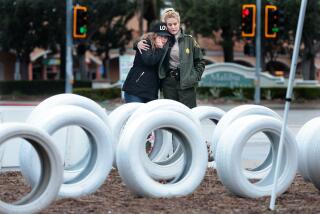Focus on Fines for Red-Light Running
- Share via
SACRAMENTO — Wading into an area that pits police against automobile organizations, members of the state Legislature are debating a bill that would make it easier for police to fine motorists $200 for running a red light if a camera captured an image of the vehicle in the act.
Under current law, police must be able to clearly identify the driver of a red-light-busting vehicle as its registered owner before they issue citations.
The new bill would change that by allowing police to cite motorists even if the driver was not identifiable in the picture. To escape the fine, a motorist would have to prove that his or her car was being driven by someone else when the picture was taken.
In part because of the current requirement that the driver be visible in the photograph shot by intersection cameras, fewer than 25% of the total violations recorded by the cameras are enforced, according to a 2002 estimate by the Bureau of State Audits.
In California, 29 local governments have installed cameras at certain intersections to automatically photograph motorists who blow through red lights. They include the city and county of Los Angeles, Beverly Hills, Oxnard, San Diego, Ventura and West Hollywood. Proponents say the cameras are justified by the damage that can result from drivers who rush through signals: Red-light running caused 26,181 crashes in California in 2001, resulting in 113 deaths and 15,537 injuries, according to the Highway Patrol.
Various studies agree that red-light cameras generally make intersections safer. The accident rate was reduced by 3% to 21% at intersections with cameras in five cities and counties studied by the Bureau of State Audits in 2002.
A bill, SB 780, by Sen. Tom Torlakson (D-Antioch) aims to boost the prosecution of red-light runners by allowing police to cite the owner of a vehicle photographed, regardless of who is driving. In order to protect against abuse by the companies that make and operate the cameras, the bill also would prevent them from receiving a cut of the fine revenue.
Police departments support the Torlakson bill, saying it will punish even those red-light runners who hide their faces or remove their front license plates, itself a vehicle code violation.
“It absolutely eliminates the headache for the prosecutor and Police Department, because what took all the time was the court hearings,” said Paul Cooper, a deputy city attorney in San Diego. “This way, it’s like a parking ticket -- whoever owns the car, you’re responsible.”
But opponents include the 3.6-million member California State Automobile Assn. and the 5.6-million member Automobile Club of Southern California. Those groups argue that the bill casts aside protections for a driver who lends a vehicle to a reckless friend.
The two organizations also dislike a provision in the bill that imposes a $200 civil fine for red-light runners caught by a camera, while those caught by a police officer must pay a $340 moving violation fine and have a point added to their driving record. (A person’s driver’s license can be revoked upon accumulation of more than four points in one year.)
“SB 780 in our opinion goes in the wrong direction, because it makes it more difficult for innocent drivers to challenge these tickets,” Anne Drumm, lobbyist for the Automobile Club of Southern California, told the Senate Judiciary Committee on Tuesday.
Several members of the committee expressed concern that the appeals process set up by the bill is too cumbersome. Others worried that the legislation has no teeth to revoke the licenses of repeat red-light violators. Still, the bill was approved by the committee, though by a single vote.
The Torlakson legislation goes further than another pending bill, one sponsored and supported by the auto clubs. That bill, AB 1022 by Assemblywoman Jennie Oropeza (D-Long Beach), aims to boost driver confidence in the fairness of California’s 6-year-old red-light camera program by tightening government controls on the three private companies that operate the cameras. It passed the Assembly Transportation Committee on Monday, 20 to 0.
Like SB 780, Oropeza’s bill would prohibit the private vendors from being paid a percentage of the fine revenue. That provision is intended to eliminate any incentive to manipulate photos for profit. Her bill would also require that police officers, not company employees, determine who gets mailed a citation, and it would require the companies to keep driver information confidential.
Three private companies -- Affiliated Computer Services Inc., Nestor Traffic Systems and Redflex Traffic Systems -- maintain red-light cameras in California. One of those vendors, ACS Inc., donated more than $59,000 to state and local politicians and parties in 2002; a lobbyist for the firm endorsed SB 780 on Tuesday. The company has taken no position on AB 1022.
The 2002 state audit found that local governments need to do a better job of supervising the vendors. A San Diego County judge expressed similar concerns in 2001 when he tossed out fines against 300 people. The judge concluded that San Diego’s vendor was essentially operating the city’s program and had a profit motive to boost the number of citations issued.
More to Read
Sign up for Essential California
The most important California stories and recommendations in your inbox every morning.
You may occasionally receive promotional content from the Los Angeles Times.










